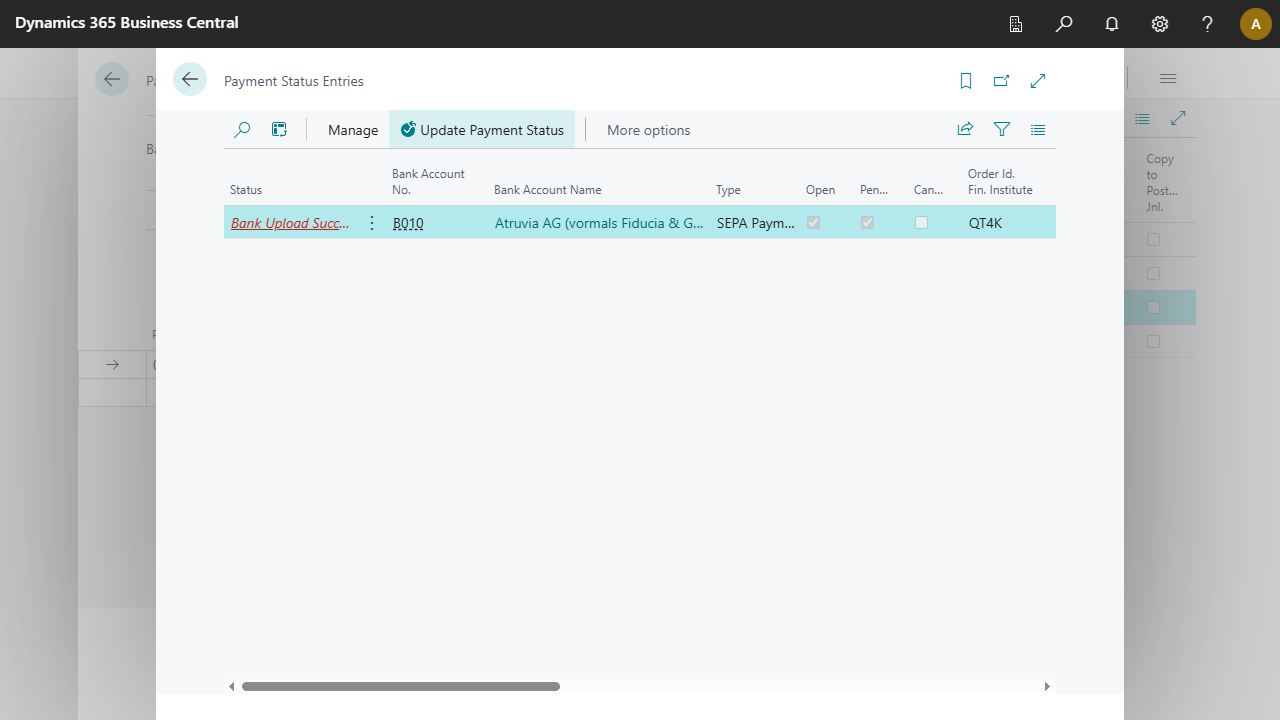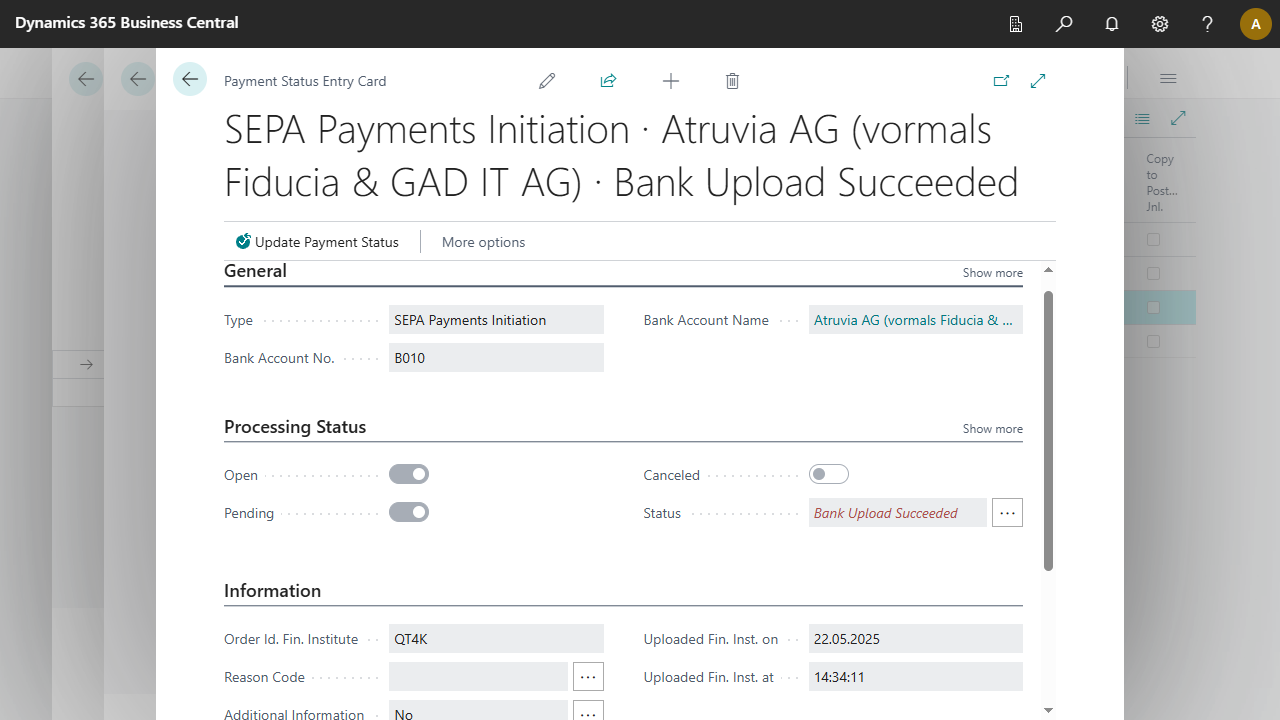
 Payment Status Entries
Payment Status Entries



| Status | Shows the processing status of the file. Status values with the prefix KON specify the status of the file within konfipay. Status values with the prefix FIN represent the status of the file within the financial institution. |
| Bank Account No. | Specifies the bank account number for which the payment file was created. |
| Bank Account Name | Specifies the name of the bank account for which the payment file was created. |
| Order Id. Fin. Institute | Shows the Order number assigned by the financial institution to the file. The Order ID is a unique identifier assigned by the financial institution to the payment file. It helps track and reference the file in communications with the bank.
This element is only available if the file possesses one of the following status values:
|
| Last Sync on | Shows the Date when the payment file was saved in konfipay. The last synchronization date shows when the payment file status was most recently updated from konfipay. This helps track the currency of the status information. |
| Last Sync at | Shows the Time when the payment file was saved in konfipay. |
| Reason Code | Shows the ISO reason code that further describes the processing status of the file within the financial institution. The reason code provides a standardized way to describe the processing status of the payment file within the financial institution. It helps identify specific issues or states during processing.
This element is only available if the file possesses one of the following status values:
|
| Uploaded Fin. Inst. on | Shows the date of the successful transmission of the file to the financial institution. The uploaded date indicates when the payment file was successfully transmitted to the financial institution. This timestamp confirms that the file has been sent and is being processed by the bank.
This element is only available if the file possesses one of the following status values:
|
| Uploaded Fin. Inst. at | Shows the time of the successful transmission of the file to the financial institution.
This element is only available if the file possesses one of the following status values:
|
| Clearing Entry No. | Shows the entry number of the related clearing entry. |
| Entry No. | Specifies the entry number assigned to the NAVAX konfipay Connector Payment File Status entry. |
| Clearing Entry No. | Shows the entry number of the related clearing entry. |
| Payment File Type | Shows what type of payment file it is.
Possible values:
|
| Bank Account No. | Specifies the bank account number for which the payment file was created. |
| Bank Account Name | Specifies the name of the bank account for which the payment file was created. |
| konfipay rId | Shows the unique reference ID of the payment file in konfipay. The konfipay rId is a unique identifier assigned by konfipay for each payment file. It serves to identify and track the file within the konfipay system. |
| Status | Shows the processing status of the file. Status values with the prefix KON specify the status of the file within konfipay. Status values with the prefix FIN represent the status of the file within the financial institution. |
| Last Sync on | Shows the Date when the payment file was saved in konfipay. The last synchronization date shows when the payment file status was most recently updated from konfipay. This helps track the currency of the status information. |
| Last Sync at | Shows the Time when the payment file was saved in konfipay. |
| Canceled by | Specifies the ID of the user who canceled the payment file. |
| Canceled at | Specifies the date when the payment file was canceled. |
| Order Id. Fin. Institute | Shows the Order number assigned by the financial institution to the file. The Order ID is a unique identifier assigned by the financial institution to the payment file. It helps track and reference the file in communications with the bank.
This element is only available if the file possesses one of the following status values:
|
| Reason Code | Shows the ISO reason code that further describes the processing status of the file within the financial institution. The reason code provides a standardized way to describe the processing status of the payment file within the financial institution. It helps identify specific issues or states during processing.
This element is only available if the file possesses one of the following status values:
|
| Additional Information | Shows additional information about the status of file within the financial institution as free text. The additional information field provides free-text details about the status of the payment file within the financial institution. It may include explanations, notes, or other relevant information that supplements the reason code and helps while troubleshooting. |
| Uploaded Fin. Inst. on | Shows the date of the successful transmission of the file to the financial institution. The uploaded date indicates when the payment file was successfully transmitted to the financial institution. This timestamp confirms that the file has been sent and is being processed by the bank.
This element is only available if the file possesses one of the following status values:
|
| Uploaded Fin. Inst. at | Shows the time of the successful transmission of the file to the financial institution.
This element is only available if the file possesses one of the following status values:
|
| Error Code | Shows the error code for clear identification of the error that has occurred. Structure of the error codes: ERR-{Category}-{Number} ERR - Fixed prefix for all error codes {Category} - Category of the error {Number} - Number of the error The number is unique within its category. For more information, see Information for Developers, konfipay. |
| Error Message | Show the textual description of the error. |
| Error Message on | Shows the date of the occurrence of the error. |
| Error Message at | Shows the time of the occurrence of the error. |


 | FinanzOnline VAT Reg. No. Validation VAT Reg. No. validation via the Austrian FinanzOnline (FON) service. More information  |